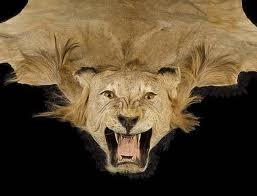News
Latest Lion Aid News
Wild lion trophy hunting in South Africa
Tuesday 13th December 2011
|
Richard Hargreaves, UK Director of the Campaign against Canned Hunting, sent me an interesting e-mail yesterday. This comes back to an earlier post on this site questioning the fact that between 2000-2009, South Africa reported an export of 2651 “wild” lion trophies in addition to 3024 “captive bred/ranched” lion trophies according to CITES records. An online search of the CITES Trade Database allows one to make distinctions among the different categories of “trophies”. We pointed out that it was absolutely impossible for South Africa to export an average of 265 “wild” trophy lions on average per year over that period, as there were simply not enough wild lions in the country to support this offtake. We suggested widespread substitution of captive bred lions made up the numbers. Mr Hargreaves pointed us to a statement by Dr Dewald Keet, Chief State Veterinarian of Kruger Park, to suggest only about 15, yes, fifteen wild lions could be available to be shot as trophies per year in South Africa. A slight difference from 265 as reported by CITES. So we will stay with our original assessment that CITES authorities in South Africa have many captive bred lions in the mix of “wild” trophies. It should be noted that false labelling is punishable by law under the Lacey Act of the United States and also under the European Union Wildlife Trade Regulations. Whether that applies to a lion trophy imported as “wild” versus “captive bred” remains to be tested in court, but the regulatory statutes are in place, and the Lacey Act authorises legal repercussions for both the importer (client) and the hunting operator. Mr Hargreaves also pointed out that there was a major discrepancy when the CITES records were searched for “all categories” versus the cumulative and specific categories of “wild” and “captive bred/ranched”. And he is right. Suddenly 997 lion trophy exports from South Africa go missing. We would expect a few errors here and there in the CITES records, but 997 trophies from 2000-2009 is a bit on the wild side. How can this have happened? Mr Hargreaves suggests double labelling, and he might be right. Nevertheless, two matters are clear, and both have to do with CITES urgently getting their house in order to investigate what is happening with issuing authorities in South Africa. First, 15 available wild lions per year cannot supply 265 trophies exported under the “wild” category. Second, a discrepancy of 997 lion trophies in their records cannot be simply attributable to clerical error. CITES (officially termed the Convention in International Trade in Endangered Species of Fauna and Flora) was established in 1973. 175 member states are now signed up to regulate international trade in wildlife species to ensure that such trade does not compromise the species’ conservation status. CITES is maintained by contributions from signatory Governments to the Convention, meaning our taxes. If CITES is responsible to us, we should reasonably expect better reporting and greater transparency?
Tags: CITES, South Africa, wild lion trophies, captive bred lion trophies, Categories: canned hunting/Captive breeding, Trophy Hunting |
Posted by Pieter Kat at 14:20
No comments have been posted yet.
Add a new comment
Existing user
New user sign up




